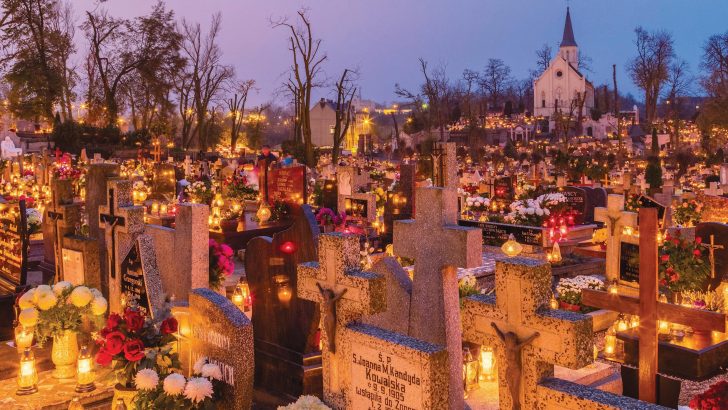Ruadhán Jones shares ideas for celebrating the unofficial triduum of Hallowe’en, All Saints and All Souls
Hallowe’en as it is celebrated today comprises a mishmash of different cultural traditions, some pagan – mostly Celtic – and some Christian. Even the origins of the celebration are somewhat controversial, with Neo-paganists attempting to ‘reclaim’ it from its Christian trappings.
However, what is certain is that Hallowe’en as we know it developed in relation to a feast which is definitely Catholic – the Solemnity of All Saints celebrated on November 1. There are more than 10,000 canonised saints in the Church, which means that not all of them can be recognised on a calendar of 365 days: All Saints Day commemorates all saints, canonised and otherwise.
This feast was first officially established by Pope Boniface IV in 615 as the “Feast of All Martyrs”. In 840, the title changed to the “Feast of All Saints” as saints other than the martyrs were added.
However, from the 4th Century until 844 this feast was celebrated on May 13. Pope Gregory IV transferred the celebration to November 1 so that it would coincide with harvest to be able to provide food for pilgrims. Some scholars argue it was moved in order to “baptise” a pagan holiday – it is possible that both accounts are correct.
Meaning
Hallowe’en, All Saints and All Souls form an unofficial triduum sometimes called “Allhallowtide”. The placement of the days is significant, expressing the Christian belief of the “Communion of Saints”. The Communion of Saints is the union of all the faithful on Earth (the Church Militant), the saints in Heaven (Church Triumphant) and the Poor Souls in Purgatory (Church Suffering).
The solemnity of All Saints commemorates the Church Triumphant; All Souls the Church Suffering; Hallowe’en is a celebration, we might argue, of the Church Militant, those pilgrims left on earth to do the Lord’s work. We celebrate with our fellow pilgrims, our earthly brothers and sisters in Christ, rejoicing in the gifts of God given to us in creation.
This act of rejoicing for the gifts of life is celebrated, in typical Catholic fashion, as a memento mori – a reminder of the inevitability of death. Many of the traditions which we now follow on Hallowe’en, such as trick-or-treating and lighting jack-o-lanterns, stem from its connection with All Saints Day and provide reminders of our death and eternal life. The symbolic location of Hallowe’en on the point of nature’s death has a Catholic, as well as a pagan, significance.
Celebrate
“The Feast of All Saints is one of the greatest of all the feasts because it celebrates what could have been impossible,” writes Mary Reed Newland in The Year and Our Children (1956). “The cross is a tree that bears fruit… Aside from all the lofty things to be said about the saints and to the saints on this day, we want our children to understand in the marrow of their bones what the principal idea is: ‘We are so glad for you. Now pray, so we’ll be there too!’”
All Saints Day and its Vigil, Hallowe’en, are days of celebration and hope first and foremost. It is a family day– we celebrate the memory of those family members, our brothers and sisters in the faith, now sharing eternal happiness in the presence of God. Unsurprisingly, a wide array of traditions have developed in connection with this great feast.
All Saints is a holy day of obligation, so as a Catholic, our first responsibility is to attend Mass (if it’s taking place) – after that, a variety of celebrations are open to us. How you spent the vigil, Hallowe’en, depended on where in Christendom you lived. For instance, in Brittany, the night was solemn and without a trace of merriment. In Ireland and Scotland, whence we draw our traditions, it was a lively combination of prayer and merriment.
Saintly costume parties
It is claimed that in the Middle Ages, churches that were too poor to display the relics of martyred saints at Allhallowtide let parishioners dress up as saints instead. This is one origin story for the practice of dressing up for Hallowe’en and All Saints. Another suggests it is linked to the practice of “guising” – dressing in disguise and going door to door for food or coins – which was common in Ireland and Scotland.
However, given the current state of the world, it seems unlikely that we’ll have the chance to trick-or-treat. But that doesn’t mean we can’t dress up! Perhaps, if your children are the right age, now’s the time to try out an All Saints costume party. These parties combine fun, elements of surprise and macabre with a focus on the aspect of the Communion of Saints.
Costumes of saints are, of course the recommended apparel. If they’ve already done their confirmation, perhaps they could dress up as their patron. It’s a great chance to explore the rich visual history of the Church, as well as the lives of the Saints. Encourage your children to do some research, perhaps preparing a short synopsis for a guessing game later in the night.
Party pieces
The party, out of respect for the feast it commemorates, traditionally combines festive and reflective elements. Having donned the costumes, it begins with a rosary dedicated to the Poor Souls. Then follows a candlelit procession to a graveyard – well, a makeshift one at least.
You can create your own graveyard out of wood or stone. Old wooden pallets or scrap lumber painted white and formed into a makeshift cross would do nicely. There should be at least four crosses, one each for:
- Departed Family
- Departed Friends
- Departed Clergy
- Forgotten Dead.
You can paint the names on the crossbar. These aren’t intended to “scare” us: they act as reminders for the souls we must remember in prayer. At each tombstone lay red berries and an evergreen branch to symbolize the passion of Christ which wrought eternal life for us. Then prayers for each group are said after the berries and evergreen are placed.
If it seems too morbid, remember that it pales in comparison with the more ghoulish of our modern Halloween practices! Once that’s done, the next few stages are more on the merriment side – party games and some fancy grub. Guessing games, scavenger hunts, bobbing for apples and other family fun should lighten the mood. As for food, well, there are plenty of options to choose from.
Soul cakes
My recommendation for this years All Saints celebration is the soul cake. In England, it was common during the Middle Ages that beggars would go from door to door, asking for food or donations in return for prayers for the holy souls. This practice became known as “souling” and the cakes frequently offered to them as “soul cakes”.
Soul cakes are essentially a type of shortbread and can become quite fancy depending on what you add. The following recipe is a traditional, English take on the cakes. You will need:
175g butter
175g caster sugar
3 egg yolks
450g self raising flour
2 tsp mixed spice
A few gratings nutmeg
About 100ml milk
100g dried currants plus handful to decorate
Demerera sugar to decorate
The recipe is as follows:
1.Preheat the oven to 190C/375F/ gas mark 5. Line several baking sheets with baking paper. Set aside.
2.Cream the butter and sugar together until light and fluffy. Beat in the egg yolks. Sift together the flour, mixed spice and nutmeg. Add to the creamed mixture along with the milk to give you a soft dough that you can easily roll out.
3.Roll the dough out on a lightly floured surface with a lightly floured rolling pin to 1/3 inch thickness. Cut into rounds with a 3 inch biscuit cutter. Using the dull side of a knife mark a light cross indentation into the tops of each biscuit. Push currants into the crosses. Sprinkle with a bit of demerara sugar and place about 2 inches apart on the baking trays.
4.Bake for 10 to 15 minutes until puffed and golden brown. Scoop off onto a wire rack to cool completely.
Hallowe’en tends to overshadow the feast of All Saints, but by celebrating with a saints costume party and themed cooking, the two become a wonderful mix! Even if you don’t follow them to the letter, I hope these ideas provide some useful inspiration.


 Ruadhán Jones
Ruadhán Jones

